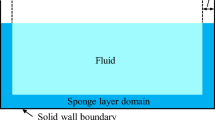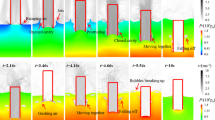Abstract
Cavity formation during water entry of a solid corresponds to the deceleration experienced by the solid. Several experimental studies in the past have facilitated qualitative understanding of the relation between flow and impact properties and the type of cavity formed. The types of cavities formed are classified primarily based on the nature of the seal, such as (a) surface seal, (b) deep seal, (c) shallow seal and (d) quasi-static seal. The flow mechanism behind these features and their effects on the speed of the impacting solid require further quantitative understanding. A study of such phenomenon is difficult using the existing CFD techniques owing to the fact that the high density ratios between the two phases, namely water and air, bring in issues with respect to the convergence of the linear system used to solve for the pressure field for a divergence-free velocity field. Based on a free surface modeling method, we present Incompressible Smoothed Particle Hydrodynamics (ISPH) simulations of water entry of two-dimensional solids of different shapes, densities and initial angular momenta. From the velocity field of the fluid and shape of the cavity, we relate the transfer of kinetic energy from the solid to the fluid through different phases of the cavity formation. Finally, we present a three-dimensional simulation of water entry to assert the utility of the method for analysis of real life water entry scenarios.




















Similar content being viewed by others
References
Yan H, Liu Y, Kominiarczuk J and Yue D K P 2009 Cavity dynamics in water entry at low froude numbers. J. Fluid Mech. 641: 441–461
Worthington A M and Cole R S 1897 Impact with a liquid surface, studied by the aid of instantaneous photography. Philos. Trans. R. Soc. A 189: 137–148
Gilbarg D and Anderson R A 1948 Influence of atmospheric pressure on the phenomena accompanying the entry of spheres into water. J. Appl. Phys. 19(2): 127–139
May A and Woodhull J C 1948 Drag coefficients of steel spheres entering water vertically. J. Appl. Phys. 19(12): 1109–1121
May A 1951 Effect of surface condition of a sphere on its water-entry cavity. J. Appl. Phys. 22(10): 1219–1222
May A 1952 Vertical entry of missiles into water. J. Appl. Phys. 23(12): 1362–1372
Richardson E G 1948 The impact of a solid on a liquid surface. Proc. Phys. Soc. 61(4): 352
Glasheen J W and McMahon T A 1996 A hydrodynamic model of locomotion in the basilisk lizard. Nature 380(6572): 340–341
Holland K T, Green A W, Abelev A and Valent P J 2004 Parameterization of the in-water motions of falling cylinders using high-speed video. Exp. Fluids 37(5): 690–700
Chu P C, Fan C, Evans A D and Gilles A 2004 Triple coordinate transforms for prediction of falling cylinder through the water column. J. Appl. Mech. 71(2): 292–298
Truscott T T, Epps B P and Belden J 2014 Water entry of projectiles. Annu. Rev. Fluid Mech. 46: 355–378
Techet A H and Truscott T T 2011 Water entry of spinning hydrophobic and hydrophilic spheres. J. Fluid. Struct. 27(5): 716–726
Truscott T T and Techet A H 2006 Cavity formation in the wake of a spinning sphere impacting the free surface. Phys. Fluids 18(9): 91113–91113
Truscott T T and Techet A H 2009 A spin on cavity formation during water entry of hydrophobic and hydrophilic spheres. Phys. Fluids 21(12): 121703
Truscott T, Belden J and Hurd R 2014 Water-skipping stones and spheres. Phys. Today 67(12): 70–71
Birkhoff G et al 2012 Jets, wakes, and cavities. Elsevier, Amsterdam
Ahmadzadeh M, Saranjam B, Hoseini Fard A and Binesh A R 2014 Numerical simulation of sphere water entry problem using Eulerian–Lagrangian method. Appl. Math. Model. 38(5–6): 1673–1684
Gingold R A and Monaghan J J 1977 Smoothed particle hydrodynamics – theory and application to non-spherical stars. Mon. Not. R. Astron. Soc. 181: 375–389
Monaghan J 1985 Particle methods for hydrodynamics. Comput. Phys. Rep. 3(2): 71–124
Monaghan J J 2005 Smoothed particle hydrodynamics. Rep. Prog. Phys. 68(8): 1703
Cummins S J and Rudman M 1999 An SPH projection method. J. Comput. Phys. 152(2): 584–607
Nair P and Tomar G 2015 Volume conservation issues in incompressible smoothed particle hydrodynamics. J. Comput. Phys. 297: 689–699
Nair P and Tomar G 2014 An improved free surface modeling for incompressible SPH. Comput. Fluids 102: 304–314
Greenhow M and Lin W-M 1983 Nonlinear-free surface effects: experiments and theory. Technical Report, DTIC Document
Truscott T T and Techet A H 2009 Water entry of spinning spheres. J. Fluid. Mech. 625: 135–165
Aristoff J M, Truscott T T, Techet A H, and Bush J W M 2010 The water entry of decelerating spheres. Phys. Fluids 22(3): 032102
Antuono M, Colagrossi A, Le Touzé D and Monaghan J J 2013 Conservation of circulation in SPH for 2D free-surface flows. Int. J. Numer. Methods Fluids 72(5): 583–606
Dehnen W and Aly H 2012 Improving convergence in smoothed particle hydrodynamics simulations without pairing instability. Mon. Not. R. Astron. Soc. 425(2): 1068–1082
Colagrossi A, Souto-Iglesias A, Antuono M and Marrone S 2013 Smoothed-particle-hydrodynamics modeling of dissipation mechanisms in gravity waves. Phys. Rev. E 87(2): 023302
Monaghan J J 1994 Simulating free surface flows with SPH. J. Comput. Phys. 110(2): 399–406
Cole R H 1948 Underwater explosions. Princeton, NJ: Princeton University Press
Lee E S, Moulinec C, Xu R, Violeau D, Laurence D and Stansby P 2008 Comparisons of weakly compressible and truly incompressible algorithms for the SPH mesh free particle method. J. Comput. Phys. 227(18): 8417–8436
Nishida A 2010 Experience in developing an open source scalable software infrastructure in Japan. In: Proceedings of Computational Science and Its Applications–ICCSA 2010, p. 448–462. Springer, Berlin
Shao S and Lo E Y M 2003 Incompressible SPH method for simulating Newtonian and non-Newtonian flows with a free surface. Adv. Water Resour. 26: 787–800
Khayyer A, Gotoh H and Shao S D 2008 Corrected incompressible SPH method for accurate water-surface tracking in breaking waves. Coast. Eng. 55: 236–250
Rafiee A and Thiagarajan K P 2009 An SPH projection method for simulating fluid–hypoelastic structure interaction. Comput. Method. Appl. Mech. Eng. 198(33–36): 2785–2795
Gotoh H and Sakai T 2006 Key issues in the particle method for computation of wave breaking. Coast. Eng. 53(2): 171–179
Koshizuka S, Nobe A and Oka Y 1998 Numerical analysis of breaking waves using the moving particle semi-implicit method. Int. J. Numer. Methods Fluids, 26: 751–769
Bøckmann A, Shipilova O and Skeie G 2012 Incompressible SPH for free surface flows. Comput. Fluids 67: 138–151
von Kármán T 1929 The impact on seaplane floats during landing. National Advisory Committee on Aeronautics
Hoover W R and Dawson V C D 1966 Hydrodynamic pressure measurements of the vertical water entry of a sphere. Technical Report, DTIC Document
Author information
Authors and Affiliations
Corresponding author
Rights and permissions
About this article
Cite this article
Nair, P., Tomar, G. A study of energy transfer during water entry of solids using incompressible SPH simulations. Sādhanā 42, 517–531 (2017). https://doi.org/10.1007/s12046-017-0615-y
Received:
Revised:
Accepted:
Published:
Issue Date:
DOI: https://doi.org/10.1007/s12046-017-0615-y




